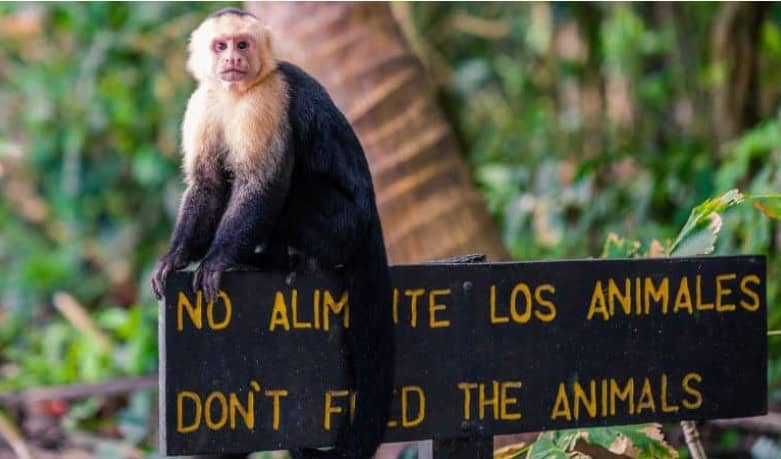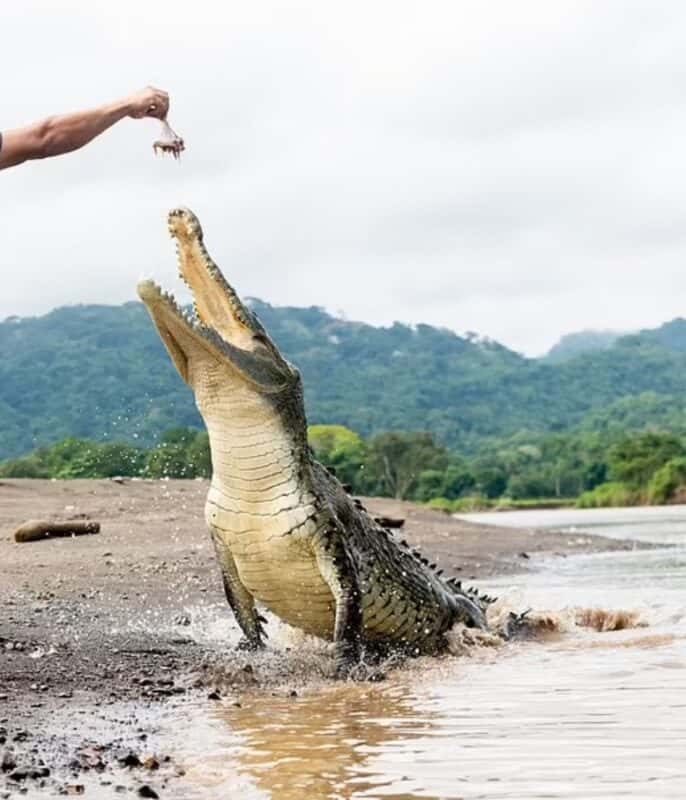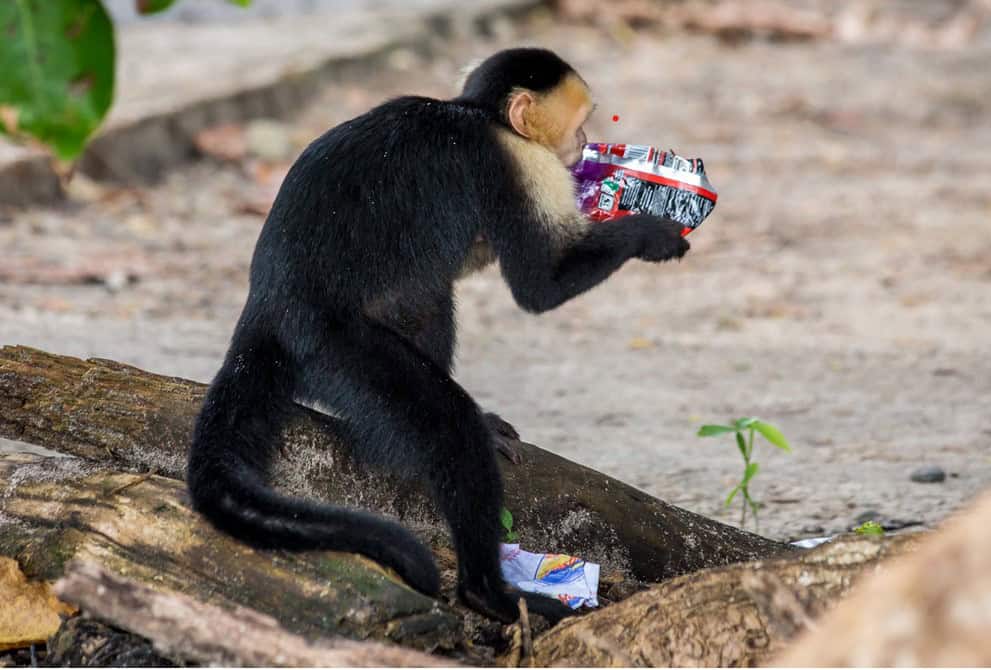There is a certain intimacy felt when gazing into the eyes, the “windows of the soul” if you will, of a wild animal. To see a wild creature, in all its splendor, behaving naturally in its native habitat is an experience that can’t be replicated in any zoo or animal sanctuary. When it comes to wildlife tourism, people will pay big money for these experiences, and when done in a manner that doesn’t alter the animal’s natural behavior, they can provide opportunities to increase appreciation and awareness of the intrinsic value of these animals, which in turn promotes empathy for other living creatures.
However, due to a lack of information available, many tourists support unscrupulous tour operators who create unnatural experiences by feeding wild animals in order to provide their clients with an up-close and personal encounter. People’s unawareness of the dangers of feeding wild animals, and tour operators’ willingness to exploit this ignorance, happens everywhere.
While Costa Rica has earned the reputation as one of the most environmentally-conscious countries in the world, with strong environmental laws to boot, the illegal practice of feeding wild animals for profit continues in the country, often openly and without legal repercussions.
In places where wild animals are known to gather, frequently there are signs that state “Don’t Feed the Wildlife.” Often these signs are expressed through images of a hand feeding an animal, with the universal prohibition sign of a red circle and slash across the image, making the undesired action clear, but offering little else in the way of context.
This begs the question of why it is wrong to feed wild animals. If confronted with this question directly, many probably would not be able to provide a complete response. While some may say that it makes the animal more aggressive or that it is bad for its health – both of which are true – most do not realize that feeding wild animals also changes their natural behaviors, which has dire consequences for the creatures’ survival.
Since every wild animal needs to utilize its skills in foraging or hunting in order to survive, by feeding these animals, humans interrupt this natural process so that the animal can become dependent on handouts and forget how to use the skills they need to obtain their own food, which can result in death from starvation. Essentially, the action of feeding enables these creatures by encouraging them to engage in behaviors that are damaging to their own health, which is not altogether different from financially supporting a person with a substance abuse problem.

The practice of feeding wildlife in Costa Rica by tour operators is especially prevalent with the crocodiles and monkeys in the Central Pacific. The town of Tárcoles is famous for its “Crocodile Bridge” and it is not a closely-guarded secret that many of the tour operators that run the boat trips in the Tárcoles River are feeding these crocs. Being reptiles, and by nature cold-blooded, crocodiles spend much of the day lying still and sunning themselves on river banks to regulate their body temperatures.
However, seeing a crocodile lie around does not garner the same amount of excitement as seeing it spring into action when on the hunt. YouTube videos of crocodiles hunting are dramatic, and in order to replicate these exhilarating experiences many tour operators will feed the crocs at Tárcoles, with guides taking personal risks by getting extremely close to the animals in order to provide tourists with a sensational Instagram-worthy video. Not only is this practice detrimental to the animals’ survival, as previously stated, but it also habituates these predators to humans.
Even though the American Crocodile, the species found in Costa Rica, is not likely to eat a human, when an individual starts to associate humans with food, the predator will instinctively go after the source of the food, and often has difficulty distinguishing between the food that the person is feeding it and the person themself. In essence, it could literally “bite the hand that feeds it” and the results may be deadly. A former employee of one of three main tour operators in Tárcoles claimed that all of the companies have been feeding the crocodiles for years, and although it is against the law, there have been little to no fines or repercussions for these actions.
Ariel Darío Lara Araya, the Wildlife Program Coordinator for the Central Pacific Conservation Area of SINAC (Sistema Nacional de Áreas de Conservación), the government agency in charge of overseeing wildlife protection, said that the wildlife conservation law (N° 7317, Article 116) states explicitly that it is illegal to feed wild animals in Costa Rica. However, enforcing this law is difficult because SINAC needs physical evidence to prove the law has been violated.

A system in place, SITADA (Sistema Integrado de Trámite de Denuncias Ambientales), allows environmental complaints to be made, and SINAC conducts investigations based on these complaints, but when they go to the sites of where these alleged infractions are incurring, it is difficult to find conclusive evidence, without catching the offenders redhanded.
While visual evidence, such as online photos or videos of guides feeding crocodiles, can be sent to the prosecutor’s office for due process, if deemed an infraction has taken place, the punishments usually involve negligible fines. While a more powerful deterrent may be the threat of closing down the business, SINAC does not have the authority to take this action, since the businesses that allegedly feed the animals are not categorized under “wildlife management,” as stipulated by the environmental legislation, so SINAC has little more they can do to discourage breaking environmental laws.
Not to be outdone by the crocodile tours, just north of Quepos, there are companies that offer clients an intimate experience with White-faced Capuchin Monkeys by taking them on boats into the mangroves of Isla Damas, and encouraging them to feed the monkeys right out of their own hands.
On many accounts, the monkeys crawl over the guests to get to the food. Although these primates may not present the same immediate physical danger that a crocodile may pose, the animals are equally harmed from a behavioral point of view when people feed them.
Just a few kilometers south of Damas, in Manuel Antonio National Park, one can see the most egregious display of what happens when people feed the Capuchin Monkeys. Here it is well known that the monkeys are so accustomed to being fed by the park visitors, that they now aggressively steal food, as well as backpacks, purses, or any belonging that may contain something edible. While the park states that people should not feed the animals, and have even put up signs that state this explicitly, the monkeys lie in wait near the kiosks that sell food next to the beach.
In fact, many guests find it charming and amusing to see these little thieves in action. There is no visible enforcement here of any significance, which in part is due to a lack of government resources that prevents SINAC from carrying out its responsibilities in preventing human-wildlife interactions. According to Mr. Lara, a measure enacted on February 21, 2021 prohibits visitors from bringing food into Manuel Antonio National Park, and although park officials check the bags of all guests upon entering the park, there are those that smuggle in food without detection.

In addition, the park only has about 3 to 5 rangers to administer the rules, due to a policy within MINAE (Ministerio de Ambiente y Energía – the ministry which oversees SINAC) that allocates all resources equally among the national parks in the Central Pacific Conservation Area. This means that a scarcely-visited national park, such as La Cangreja, has the same number of staff as Manuel Antonio, one of the most visited parks in the country.
There are some ways to address this problem. A better informed consumer will make more responsible decisions. Therefore, one idea is to start with better signage that doesn’t just say “Don’t Feed the Wildlife,” but explains why we shouldn’t feed them. Most tourists, both domestic and international, don’t want to see Costa Rica’s famous wild animals harmed, especially through actions of their own making. Therefore, clear and carefully-worded signs, placed strategically in plain view in the areas where feedings are most common, could help raise awareness of the threats associated with feeding animals.
While SINAC takes the feeding of wild animals seriously, it is clear that a lack of funding and inability to enforce environmental laws on the books has handcuffed the agency, preventing it from taking significant action to curb these malpractices. Through community advocacy, governments can be influenced to allocate funds and personnel in areas where feeding is more pervasive, such as in Manuel Antonio or Tárcoles. Through the implementation of an additional tax on park entrances and services, income could be generated for additional staff for SINAC to help conduct more thorough investigations of tour operators who are allegedly feeding wildlife.
Any additional income could be used to hire more park rangers that could make sure that visitors are not feeding animals in the parks. They should serve not to intimidate tourists, but rather to inform them of the proper way to interact with the wildlife. Instead of simply being told to stop, a person is most likely to change their behavior if they know the reasons why their actions are harmful. It is important to do this in a manner that does not scold, but rather educates.
Wagging a finger at someone usually results in the person digging in their heels and doubling down on their behaviors. While education is important, not to be overlooked is the way in which we educate others, if the ultimate goal is to affect change for the wellbeing of Costa Rica’s most charismatic denizens.
About the Author
Ryan Meczkowski is a Naturalist Guide and Founder of CR Naturalist Experiences, which offers
night tours and educational nature excursions in Uvita de Osa. Email: cr.naturalist@gmail.com
WhatsApp +506 6132 9436
